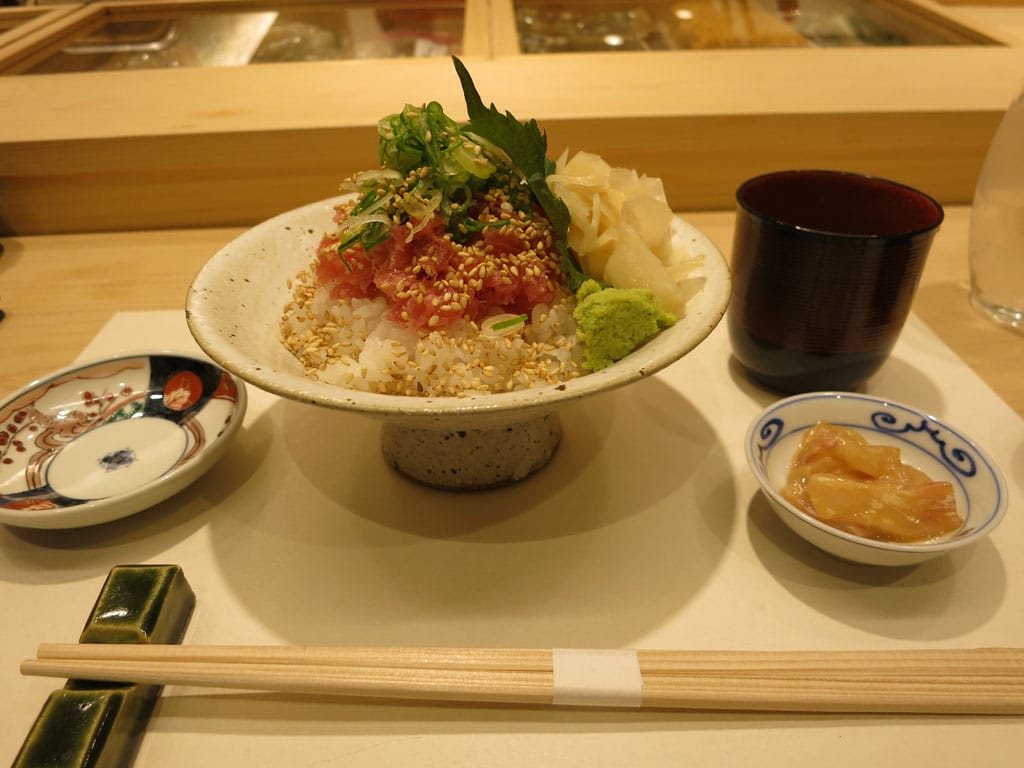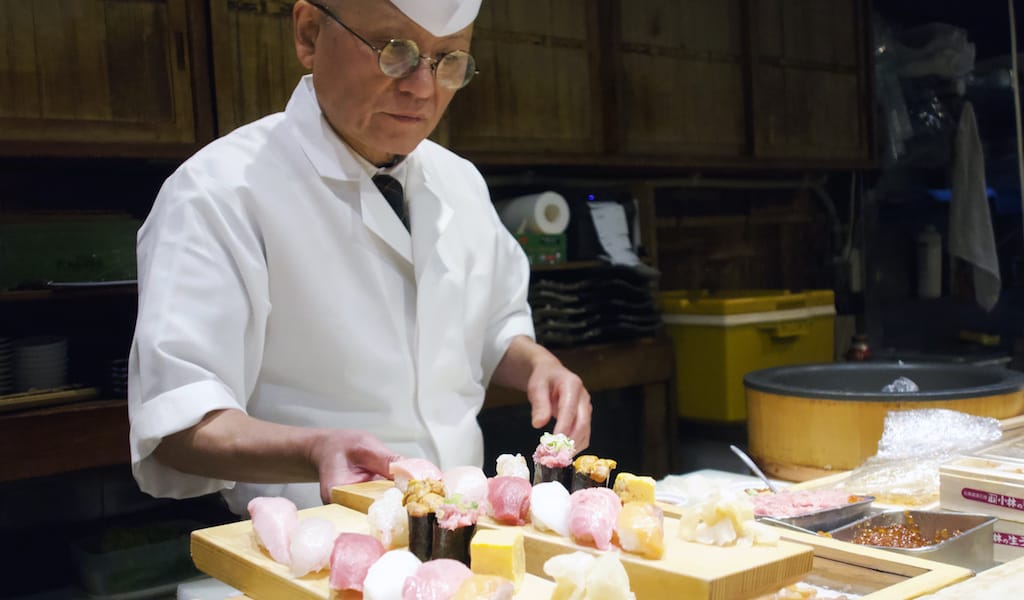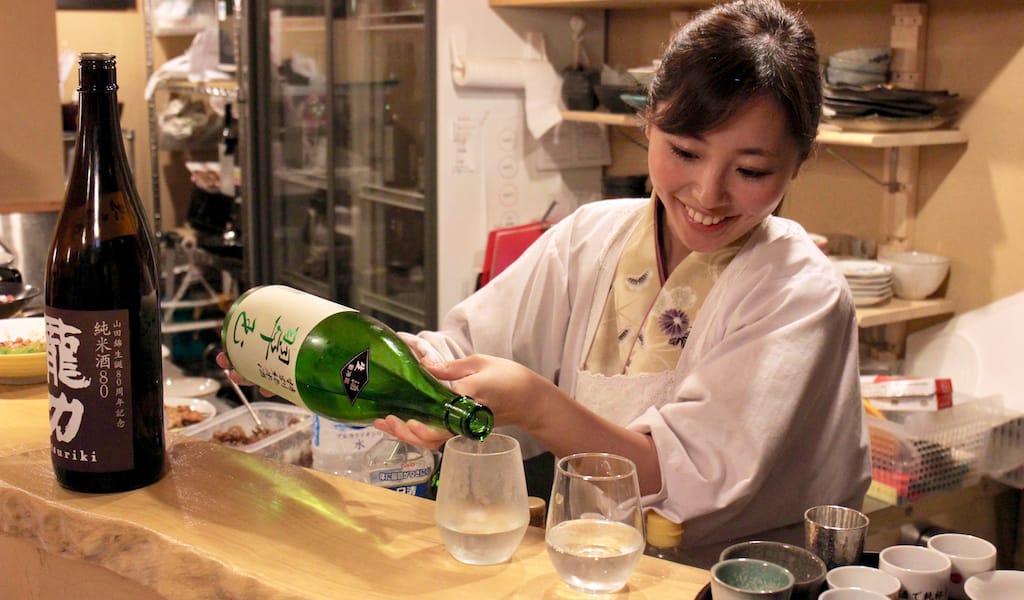Nakaochi appears to be a chopped-up mound of Japanese tuna, but it isn’t. It looks like it should be an inexpensive cut of fish, but it’s not. Instead it’s a rare delicacy, a one-of–a-kind culinary experience we can’t get enough of.
Nihonbashi Maishi looks like just another restaurant grouped in the basement compound of the Tokyo Nihonbashi Tower, but it isn’t. It appears to be an ultra-expensive establishment, but at lunchtime it’s not. It’s a favorite go-to place for true aficionados of Edo-mae sushi and nakaochi.
Edo-mae sushi is considered the root of all sushi. Although forms of raw fish and rice were eaten in areas of Asia before the early 19th century, most raw fish in Japan at the time was eaten as sashimi without rice, and there was no sushi as we know it. There was almost no refrigeration, and ice was costly, so raw fish had to be eaten soon after catching it. As a samurai working class began to grow in the nation’s capital of Edo (now Tokyo) during the early 1800s, there arose a demand for fast food to feed workers in a hurry. Stalls popped up selling tempura, soba and eventually sushi. Edo-mae refers to the style of sushi first sold and served in Tokyo, “Edo” meaning Tokyo and “mae” meaning “front of.”
The neta, or local ingredients, of Edo-mae sushi came mainly from Tokyo Bay. The most prolific fish was maguro (tuna). The fatty parts were difficult to keep and transport, but the fleshy akami (red meat) became very popular. Edo-mae establishments were judged by the quality of the tuna they served, and that remains the yardstick even today.
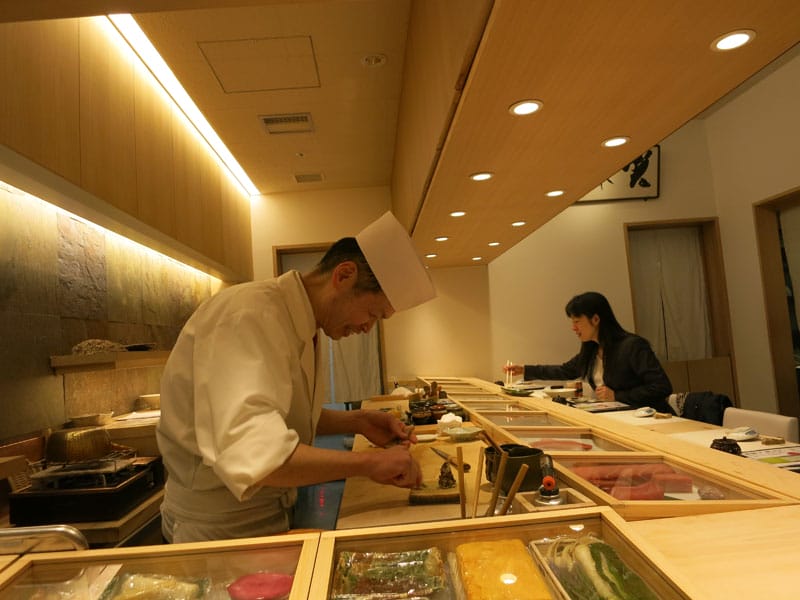
It’s quite tempting to eat past our nakaochi reverie and go on to eat more Edo-mae sushi a la carte. An Edo-mae sushi chef prides himself on the quality of his fish and also the rice. Many sushi chefs include a pinch of sugar in their sushi rice, but with Edo-mae sushi it’s all about the balance of rice, vinegar and salt. At Nihombashi Maishi, high-quality tuna sashimi is served in the Edo tradition: the fish is lightly steeped in soy sauce for a short time so that the salt content can preserve it slightly, but it retains its texture.
Another highlight would be unagi (freshwater eel), which has always been a staple of Edo-mae sushi because an eel is cut open from the back and not through the stomach, a requirement for all fish eaten by ancient samurai, who practiced ritual suicide by cutting their stomachs.
Many Western sushi fans know the slimy pink stuff packed into spicy tuna rolls at the supermarket or local sushi bar as tuna. That incarnation of tuna is in fact scrap fish scuffed from the bones of tuna caught in waters around the world, usually mixed with snippets from other fish and then frozen into blocks to be shipped to eager sushi fans worldwide. One could easily call it nakaochi of a sort, but it doesn’t hold a candle to the real thing.
Because Nihombashi Maishi prides itself on the quality of its tuna, nakaochi scraped from the bones of high-quality tuna is served as a dish by itself for those who enjoy the delicacy. The lunch teishoku course arrives with an abundance of perfect sushi rice topped with an array of nakaochi, cucumbers, gari (pickled ginger) and a shiso leaf and is flaked with sesame seeds to seal the deal. Two small dishes and a lovely lacquer bowl of miso soup accompany the nakaochi. One dish is soy sauce for dipping. The other seems mysterious at first with some sort of salted fish and we are instructed to leave it for last. We are also instructed not to finish the rice under the tuna.
Nakaochi has its own particular taste, slightly sweeter than most tuna and, when served lukewarm (close to body temperature), is oddly comforting and mellow. It feels difficult not to pick up the bowl and consume the whole thing in big, gulping mouthfuls. A server returns when the nakaochi is gone and we’ve managed to leave a dainty bit of rice remaining. She delicately pours a broth over the rice and shovels the salty fish from the side dish into the rice bowl to make a version of ochazuke. The hot, salty broth is a surprising contrast to the umami blast of the nakaochi and is the perfect coda to the meal. This is the delicacy of Japanese cuisine at its best.
Editor’s note: We regret to report that Nihonbashi Maishi is closed.
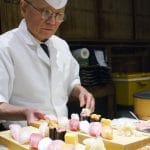 January 29, 2019 Market Watch
January 29, 2019 Market Watch
Mark Twain once famously remarked, “The reports of my death are greatly exaggerated.” […] Posted in Tokyo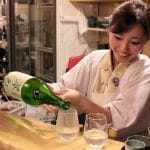 December 12, 2018 Best Bites 2018
December 12, 2018 Best Bites 2018
This was a year of culinary highs for sure, one that involved freshwater eel, lamb […] Posted in Tokyo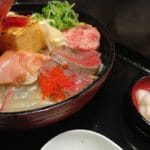 June 17, 2016 Ichiba no Chubo
June 17, 2016 Ichiba no Chubo
The warren of streets surrounding Tsukiji – Tokyo’s main wholesale market – are filled […] Posted in Tokyo
Published on June 28, 2016
Related stories
January 29, 2019
TokyoMark Twain once famously remarked, “The reports of my death are greatly exaggerated.” Perhaps Tokyo’s beloved and historic Tsukiji Market can say the same. Several years ago the Metropolitan government declared that Tokyo’s Tusikiji fish market needed to be relocated to a more efficient and workable location. Construction was begun on a new state-of-the-art site…
December 12, 2018
TokyoThis was a year of culinary highs for sure, one that involved freshwater eel, lamb ramen, sake and more. Kyuri Cucumbers at Sobaya Nicolas Following a visit to Kyoto’s Nishiki Market, I felt myself yearning for local kyo yasai, vegetables from the Kansai region of Japan. That night we were invited by a local artisan…
June 17, 2016
TokyoThe warren of streets surrounding Tsukiji – Tokyo’s main wholesale market – are filled with sushi joints, ramen stands, coffee shops and assorted other restaurants tucked between the stalls and knife makers.Walking around during morning hours, one might often wonder where the people who work inside the market have their meals. The gentrification of Tsukiji…







































